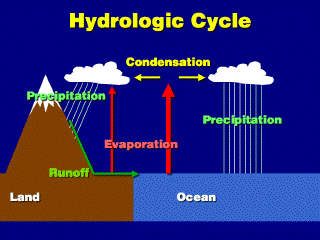 Water circulates around the Earth and atmosphere, partly as a way of transporting
latent heat in an effort to create global energy balance (recall that radiatively,
the tropics and the poles
are out of radiative balance and need weather systems and the ocean to transport
heat poleward).
Water circulates around the Earth and atmosphere, partly as a way of transporting
latent heat in an effort to create global energy balance (recall that radiatively,
the tropics and the poles
are out of radiative balance and need weather systems and the ocean to transport
heat poleward).
An important step in this energy
transport is the evaporation of water from the Earth's surface, the transport
of this vapor upward, and the subsequent condensation of the vapor into clouds,
which then precipitate the water back to the Earth's surface. Concepts of humidity
control the rate of evaporation and the time and place that condensation of
the cloud water occurs. Later, we'll look at other factors that control the
formation of the clouds (stability of the atmosphere leading to varying degrees
of vertical motion, resulting in different types and amounts of cloud) and of
precipitation.


 Water circulates around the Earth and atmosphere, partly as a way of transporting
latent heat in an effort to create global energy balance (recall that radiatively,
the tropics and the poles
are out of radiative balance and need weather systems and the ocean to transport
heat poleward).
Water circulates around the Earth and atmosphere, partly as a way of transporting
latent heat in an effort to create global energy balance (recall that radiatively,
the tropics and the poles
are out of radiative balance and need weather systems and the ocean to transport
heat poleward).